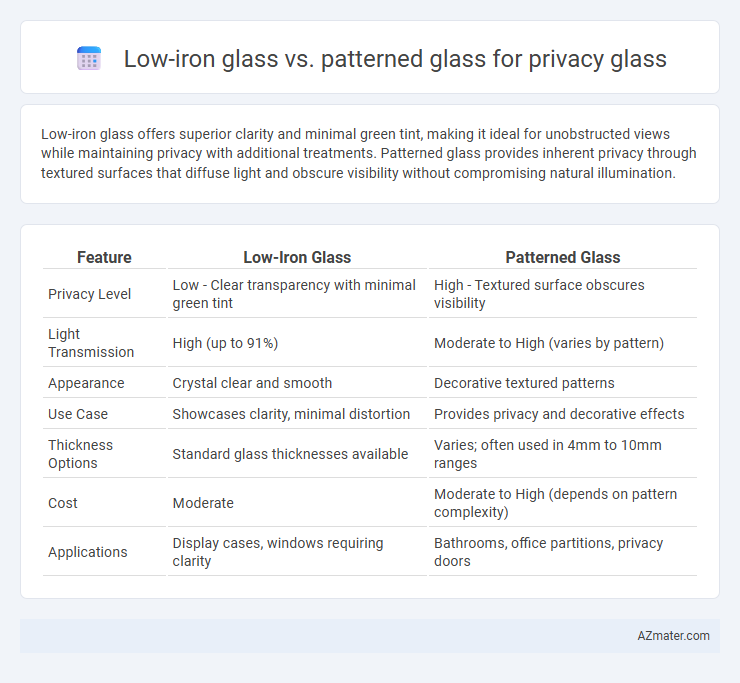Low-iron glass offers superior clarity and minimal green tint, making it ideal for unobstructed views while maintaining privacy with additional treatments. Patterned glass provides inherent privacy through textured surfaces that diffuse light and obscure visibility without compromising natural illumination.
Table of Comparison
| Feature | Low-Iron Glass | Patterned Glass |
|---|---|---|
| Privacy Level | Low - Clear transparency with minimal green tint | High - Textured surface obscures visibility |
| Light Transmission | High (up to 91%) | Moderate to High (varies by pattern) |
| Appearance | Crystal clear and smooth | Decorative textured patterns |
| Use Case | Showcases clarity, minimal distortion | Provides privacy and decorative effects |
| Thickness Options | Standard glass thicknesses available | Varies; often used in 4mm to 10mm ranges |
| Cost | Moderate | Moderate to High (depends on pattern complexity) |
| Applications | Display cases, windows requiring clarity | Bathrooms, office partitions, privacy doors |
Understanding Low-Iron Glass: Features and Benefits
Low-iron glass offers superior clarity and enhanced light transmission compared to regular patterned glass, making it ideal for privacy applications that demand brightness and unobstructed views. Its reduced iron content minimizes the typical greenish tint found in traditional glass, ensuring a more natural and clean appearance in interior spaces. While patterned glass obscures visibility through texture, low-iron glass can be combined with films or treatments to maintain privacy without compromising on transparency or aesthetic quality.
What is Patterned Glass? Types and Applications
Patterned glass is a type of textured glass featuring various surface designs that obscure vision while allowing light to pass through, enhancing privacy in spaces like bathrooms, office partitions, and doors. Common types include rain, reed, glue chip, and fluted patterns, each providing unique aesthetic and functional attributes suited for both residential and commercial applications. Patterned glass is preferred for its decorative appeal and effective light diffusion, distinguishing it from low-iron glass, which prioritizes clarity and transparency over privacy.
Privacy Glass Options: Key Differences
Low-iron glass offers superior clarity and minimal green tint, enhancing natural light transmission while maintaining privacy through frosted or tinted finishes. Patterned glass provides textured surfaces that obscure visibility by distorting images, ideal for areas requiring visual privacy without sacrificing light. The key difference lies in low-iron glass emphasizing clarity with privacy coatings, whereas patterned glass relies on surface texture to achieve privacy.
Optical Clarity: Low-Iron vs Patterned Glass
Low-iron glass provides superior optical clarity compared to patterned glass due to its reduced iron content, which minimizes the greenish tint commonly found in standard glass. Patterned glass, designed with textured surfaces for privacy, scatters light and distorts images, resulting in lower transparency and less clear views. For applications requiring both privacy and high visual clarity, low-iron glass combined with additional privacy solutions offers a clearer appearance than traditional patterned glass.
Light Transmission and Diffusion Comparison
Low-iron glass offers higher light transmission with minimal color distortion, allowing more natural light to pass through while maintaining clarity. Patterned glass provides moderate light diffusion, scattering light to obscure visibility and enhance privacy but reducing overall transparency. The choice between low-iron and patterned glass depends on whether maximizing light transmission or achieving greater privacy through diffusion is the priority.
Aesthetic Impact on Interior and Exterior Spaces
Low-iron glass offers enhanced clarity and natural light transmission, creating a sleek, modern aesthetic that highlights interior colors and textures while maintaining unobstructed views from the exterior. Patterned glass introduces texture and design elements that distort visibility, providing privacy without sacrificing decorative appeal, often adding a tactile or artistic dimension to both interior and exterior spaces. Choosing between low-iron and patterned glass depends on balancing the desire for clear transparency versus textured privacy to influence the ambiance and interaction of light in architectural settings.
Privacy Levels: Which Glass Offers Better Obscuration?
Low-iron glass provides clearer visibility with minimal color distortion, offering moderate privacy by reducing glare but not significantly obscuring objects behind it. Patterned glass, featuring textured or frosted designs, delivers superior obscuration by scattering light and blurring shapes, making it ideal for high privacy applications. For maximum privacy levels, patterned glass outperforms low-iron glass by effectively preventing clear visibility while maintaining natural light transmission.
Durability and Maintenance Considerations
Low-iron glass offers enhanced durability due to its high purity and resistance to discoloration, making it suitable for long-term use with minimal fading or yellowing. Patterned glass, while providing effective privacy through texture, may require more careful cleaning to prevent dirt accumulation in grooves and can be more prone to surface scratches over time. Maintenance for low-iron glass is generally straightforward with standard glass cleaners, whereas patterned glass benefits from gentle cleaning techniques to preserve its textured design and durability.
Cost Analysis: Low-Iron Glass vs Patterned Glass
Low-iron glass typically costs 30% to 50% more than patterned glass due to its higher purity and clarity, making it a premium option for applications requiring enhanced visibility and aesthetics. Patterned glass is more economical and effective for privacy, offering numerous textured designs that obscure visibility while reducing production costs. When prioritizing budget constraints, patterned glass provides a cost-efficient solution, whereas low-iron glass demands higher investment but delivers superior light transmission and minimal color distortion.
Best Use Cases: How to Choose the Right Privacy Glass
Low-iron glass offers superior clarity and minimal color distortion, making it ideal for privacy applications in modern office partitions and residential windows where natural light and visibility remain important. Patterned glass provides textured surfaces that effectively obscure views, suited for bathroom windows, shower enclosures, and decorative panels requiring enhanced privacy without sacrificing light diffusion. Choosing the right privacy glass depends on balancing transparency needs, aesthetic preferences, and the level of obscurity required for the specific environment.

Infographic: Low-iron glass vs Patterned glass for Privacy glass
 azmater.com
azmater.com